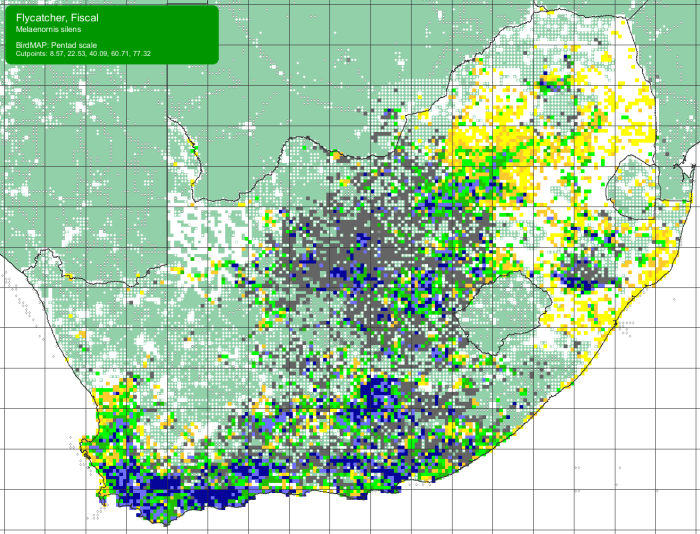Cover image of Fiscal Flycatcher by Michael Brooks – Citrusdal, Western Cape – BirdPix 4619 Fiscal Flycatcher
Identification
The Fiscal Flycatcher is smaller (17–20c m) and less aggressive bird than its shrike look-alike – the Southern Fiscal – despite being similar in many other attributes such as perching and hunting habits. An easy way to distinguish the Fiscal Flycatcher from the Southern Fiscal is by the Southern Fiscal’s stronger hook on the bill and its white, V-shaped shoulder markings.
Male and female Fiscal Flycatchers look a little different from one another. Males have a black head and back with white underparts and a white wing marking about midway down the wing.

Females and juveniles are similar in appearance to the males but are more blackish-brown or greyish-brown in colour. Juveniles are often duller and more mottled than females. Fiscal Flycatchers have black eyes, bill, feet and legs.

Distribution
The Fiscal Flycatcher is endemic to southern Africa. It occurs from south-eastern Botswana and southern Mozambique to Swaziland and most of South Africa.

Habitat
Fiscal flycatchers generally favours open habitats with scattered trees or bushes, such as moist and semi-arid grasslands, woodlands, and savannas. They are also found in fynbos and Nama Karoo scrubland. This species is most common in ecotones between two habitats; one with fairly dense thicket used for nesting and another with large patches of open ground for foraging.
Fiscal Shrikes use trees, bushes, and fenceposts as perches to scan for prey (insects).


Behaviour
The Fiscal Flycatcher mainly eats small insects supplemented with fruit. It does most of its foraging from a high perch, pouncing on prey on the ground or occasionally hawking insects from the air.

Breeding season starts in July and peaks from October to December. The female constructs the bulky cup-shaped nest which is made from stems of dry grass and combined with other plants, such as everlastings (Helichrysum) and slangbos (Stoebe). In urban areas items like string and bits of rags will also be used for the nest.
The female lays two to four eggs, which she incubates for about 13-16 days. During this time, the male brings food for the female.

Fiscal Flycatchers are important insectivores; together with other bird species they help control ant, termite, moths, mealy bugs and other ‘pest’ species.
Further Resources
Species text from the first Southern African Bird Atlas Project (SABAP1), 1997.
Virtual Museum (BirdPix > Search VM > By Scientific or Common Name).
Other common names: Fiskaalvlieëvanger (Afrikaans); Icola (Xhosa); Klauwiervliegenvanger (Dutch); Gobemouche fiscal (French); Würgerschnäpper (German).
Recommended citation format: Loftie-Eaton M and Daniel KA 2022. Fiscal Flycatcher Melaenornis silens. Bird Feeder Project. Biodiversity and Development Institute. Available Online at http://thebdi.org/2022/11/15/fiscal-flycatcher-melaenornis-silens/

